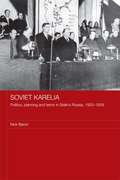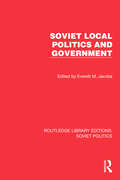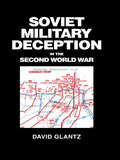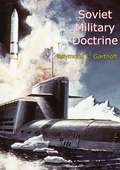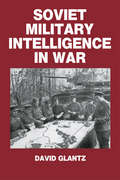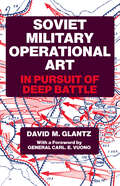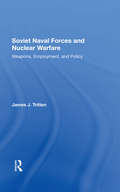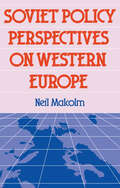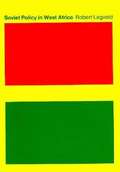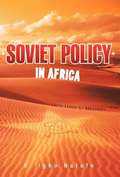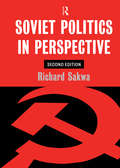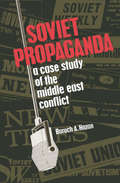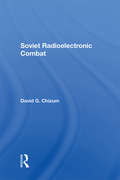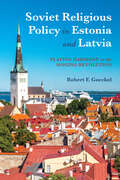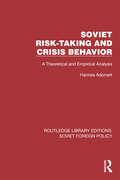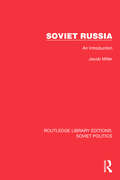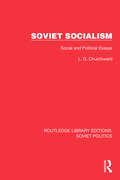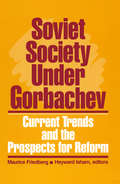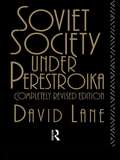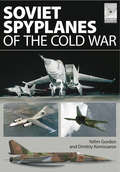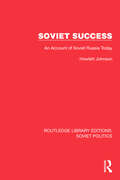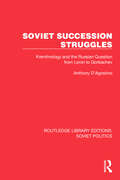- Table View
- List View
Soviet Internationalism after Stalin
by Tobias RupprechtThe Soviet Union is often presented as a largely isolated and idiosyncratic state. Soviet Internationalism after Stalin challenges this view by telling the story of Soviet and Latin American intellectuals, students, political figures and artists, and their encounters with the 'other' from the 1950s through the 1980s. In this first multi-archival study of Soviet relations with Latin America, Tobias Rupprecht reveals that, for people in the Second and Third Worlds, the Cold War meant not only confrontation with an ideological enemy, but also increased interconnectedness with distant world regions. He shows that the Soviet Union looked quite different from a southern rather than a western point of view and also charts the impact of the new internationalism on the Soviet Union itself in terms of popular perceptions of the USSR's place in the world and its political, scientific, intellectual and cultural reintegration into the global community.
Soviet Karelia: Politics, Planning and Terror in Stalin's Russia, 1920–1939 (BASEES/Routledge Series on Russian and East European Studies)
by Nick BaronIn 1920, Lenin authorised a plan to transform Karelia, a Russian territory adjacent to Finland, into a showcase Soviet autonomous region, to show what could be achieved by socialist nationalities policy and economic planning, and to encourage other countries to follow this example. However, Stalin’s accession to power brought a change of policy towards the periphery - the encouragement of local autonomy which had been a key part of Karelia’s model development was reversed, the state border was sealed to the outside world, and large parts of the republic's territory were given over to Gulag labour camps controlled by the NKVD, the precursor of the KGB. This book traces the evolution of Soviet Karelia in the early Soviet period, discussing amongst other things how political relations between Moscow and the regional leadership changed over time; the nature of its spatial, economic and demographic development; and the origins of the massive repressions launched in 1937 against the local population.
Soviet Local Politics and Government (Routledge Library Editions: Soviet Politics)
by Everett M. JacobsSoviet Local Politics and Government (1983) examines the local government system of the Soviet Union, an important part of the great bureaucracy that ran the country. The leading experts contributing to this book look at the wide range of duties that the local soviets managed, including supervision of the economic plan in their area, control over construction and agriculture, healthcare, housing, transport and infrastructure, and the attempts to adapt the local government system to new circumstances and requirements.
Soviet Military Deception in the Second World War (Soviet (Russian) Military Theory and Practice #Vol. 1)
by David M. GlantzPublished in 1989, Soviet Military Deception in the Second World War is a valuable contribution to the field of Military & Strategic Studies.
Soviet Military Doctrine
by Raymond L. GarthoffOriginally published in 1953, Soviet Military Doctrine by Soviet analyst Raymond L. Garthoff was prepared as part of the research program undertaken for the United States Air Force by The RAND Corporation. At the time of its first publication, Soviet Military Doctrine was the most complete and authoritative study available of the basic military science of the USSR.“Garthoff again joins the debate on nuclear deterrence and Moscow’s military intentions. He draws on previously confidential Soviet sources—including a complete file of the Soviet general staff journal—to interpret new developments and changes in the Kremlin’s strategic policy. Highly recommended for academic libraries.”—James R. Kuhlman, University of Georgia Library, Athens
Soviet Military Intelligence in War (Soviet (Russian) Military Theory and Practice)
by Colonel David GlantzThis text is the second of three volumes written by Colonel Glantz on the contribution of intelligence and deception operations to the Soviet victory over Nazi Germany. It examines the area where intelligence and operations overlap; the nature of co-ordination between the two; and the support provided by intelligence to operational planning and execution (or the absence of such support). This is not a study of intelligence work as such, but of how intelligence can improve the chances of success on the battlefield by facilitating the more effective and economical use of troops.
Soviet Military Operational Art: In Pursuit of Deep Battle (Soviet (Russian) Military Theory and Practice)
by Colonel David GlantzDavid Glantz examines the Soviet study of war, the re-emergence of the operation level and its connection with deep battle, the evolution of the Soviet theory of operations in depth before 1941, and its refinement and application in the European theatre and the Far East between 1941 and 1945.
Soviet Naval Forces And Nuclear Warfare: Weapons, Employment, And Policy
by James J TrittenBased on formal content analysis of the writings of Admiral Sergei G. Gorshkov and past Soviet ministers of defense and heads of the Politburo, James J. Tritten interprets what the Soviets say they will do in the event of nuclear war. He then constructs a hardware and exercise analysis of the strategic employment of the Soviet Navy in a nuclear war, offering three possible cases–the a bolt from the blue, with existing forces on patrol; full mobilization; and a plausible case of partial mobilization. In addition, Dr. Tritten examines, from a Soviet perspective, concepts of deterrence, the strategic goals and missions of the fleet, nuclear targeting policy, the Sea Lines of Communication (SLOC) disruption mission, and the potential for tactical nuclear warfare limited to the sea. The author concludes by assessing the implications of Soviet politico-military planning for Western defense strategy and arms control.
Soviet Pol Perspect W Europe (Chatham House Papers)
by Neil MalcolmFirst Published in 1989. Routledge is an imprint of Taylor & Francis, an informa company.
Soviet Policy In West Africa
by Robert LegvoldThis is a study of Soviet policy in six West African countries: Ghana, Guinea, the Ivory Coast, Mali, Nigeria, and Senegal. Robert Legvold analyzes the awakening of Soviet Interest in sub-Saharan Africa and the growth, problems, and influences of the Soviet involvement from Ghana's independence in 1957 to 1968. <p><p> Those nations are significant not only because they were the first African colonies to achieve independence and therefore have had the longest involvement with the Soviet Union, but also because together they supply illustrations of every problem that Black Africa poses for an outside nation's foreign policy: from hypersensitive nationalism to what has been called neo-colonial dependence; from relative long-term stability to fundamental instability; from military coups d'état to civil war. <p> From the Soviet viewpoint the six countries range from the most progressive to the most reactionary. Each has had an interesting relationship with the Soviet Union. <p> The author considers several basic questions: How has the Soviet Union coped with the problems and opportunities created by Black Africa? How have its perceptions of Black Africa evolved during the first decade of its involvement there? Has policy shifted correspondingly with changes In these perceptions? Mr. Legvold explains why Black Africa lay largely ignored for years while Soviet leaders turned their attention to struggle and revolution in the Far East and South Asia. He has examined the Soviet and African press to trace the full evolution of Soviet attitudes and action in these countries, and has interviewed Soviet, African, and other officials. He compares Soviet policy as between one African nation and another, as well as between Africa and other continents.
Soviet Policy Toward Africa Revisited (CSIS Significant Issues)
by David AlbrightSoviet Policy Toward Africa Revisited by David Albright
Soviet Policy and Practice toward Third World Conflicts
by Stephen T. Hosmer Thomas W. WolfeThis book examines the patterns of past Soviet involvement in Third World conflicts, illuminates the political-military conditions that encourage such intervention, and explores the possible thrust of Soviet behavior that may be expected in the future.
Soviet Policy in Africa: From Lenin to Brezhnev
by O. Natufe<p>Written by Soviet politics and international relations specialist Igho Natufe, Soviet Policy in Africa offers a critical analysis of Soviet and Western foreign policies that presents a balanced perspective on the understanding and evolution of Soviet ideology and politics. <p>Using on extensive research, Natufe traces the evolution of Soviet foreign policy from 1917 through 1980, focusing on the ideological constructs of Vladimir Lenin, the founder of the Soviet state, through the contending interpretations of Joseph Stalin, and finally to Nikita Khrushchev and Leonid Brezhnev. He reveals how the Soviets continually used the tenets of Marxism-Leninism for global issues, even though their interpretations sometimes varied between individual leaders. <p>Natufe also shows how the Soviet government viewed post-1945 Europe as favorable to revolutionary tendencies, particularly in the colonies. Africa became a battleground between Eastern and Western ideologies, and Soviet policies posed opportunities and threats to the continent's independence movements. In addition, Natufe discusses China and the West, as well as presenting case studies of Soviet foreign policy. <p>Scholars and students of international politics will find Soviet Policy in Africa a well-researched, thorough study of this often-overlooked subject.</p>
Soviet Politics: In Perspective
by Richard SakwaSoviet Politics in Perspective is a new edition of Richard Sakwas successful textbook Soviet Politics: an introduction. Thoroughly revised and updated it builds on the previous editions comprehensive and accessible exploration of the Soviet system, from its rise in 1919 to its collapse in 1991. The book is divided into five parts, which focus on key aspects of Soviet politics. They are: * historical perspectives, beginning with the Tsarist regime on the eve of Revolution, the rise and development of Stalinism, through to the decline of the regime under Brezhnev and his successors and Gorbachev's attempts to revive the system * institutions of Government, such as the Communist Party, security apparatus, the military, the justice system, local government and participation * theoretical approaches to Soviet politics, including class and gender politics, the role of ideology and the shift from dissent to pluralism * key policy areas: the command economy and reform; nationality politics; and foreign and defence policy * an evaluation of Soviet rule, and reasons for its collapse. Providing key texts and bibliographies, this book offers the complete history and politics of the Soviet period in a single volume. It will be indispensable to students of Soviet and post-Soviet politics as well as the interested general reader.
Soviet Propaganda
by Bauch A. HuronFirst Published in 2017. Routledge is an imprint of Taylor & Francis, an Informa company.
Soviet Radioelectronic Combat
by David ChizumRadioelectronic combat (REC) embraces the entire range of possibilities for manipulating the electromagnetic spectrum to military advantage. Options include electronic warfare, physical destruction of electronic targets, signals intelligence, and radio-electronic concealment and deception. Developed in the early 1970s by the Soviets, it is still poorly understood in the West. This study analyzes REC as a method of warfare with which Western military thinkers must reckon seriously at all levels of combat planning. It also provides a solid base of information on REC's origins, functional structure, and basic military goals. Equally important, it defines REC's greatest threat as conceptual rather than technological. Manipulating the electromagnetic spectrum depends more on thoughtful planning and centralized control than on sophisticated equipment¡ further, the Soviets appear to be ahead of the West in integrating the concept as an institutional part of military activity. Based primarily on Soviet sources, this book not only traces the evolution of REC but also serves as a model for understanding the development of other Soviet combat concepts.
Soviet Religious Policy in Estonia and Latvia: Playing Harmony in the Singing Revolution
by Robert F. GoeckelSoviet Religious Policy in Estonia and Latvia considers what impact Western religious culture had on Soviet religious policy. While Russia was a predominantly Orthodox country, Baltic states annexed after WWII, such as Estonia and Latvia, featured Lutheran and Catholic churches as the state religion. Robert Goeckel explores how Soviet religious policy accommodated differing traditions and the extent to which these churches either reflected nationalist consciousness or offered an opportunity for subversion of Soviet ideals. Goeckel considers what negotiating power these organizations might have had with the Soviet state and traces differences in policy between Moscow and local bureaucracies. Based on extensive research into official Soviet archives, some of which are no longer available to scholars, Goeckel provides fascinating insight into the relationship between central political policies and church responses to those shifting policies in the USSR. Goeckel argues that national cultural affinity with Christianity remained substantial despite plummeting rates of religious adherence. He makes the case that this affinity helped to provide a diffuse basis for the eventual challenge to the USSR. The Singing Revolution restored independence to Estonia and Latvia, and while Catholic and Lutheran churches may not have played a central role in this restoration, Goeckel shows how they nonetheless played harmony.
Soviet Risk-Taking and Crisis Behavior: A Theoretical and Empirical Analysis (Routledge Library Editions: Soviet Foreign Policy #15)
by Hannes AdomeitSoviet Risk-Taking and Crisis Behavior, first published in 1982, examines the question: for what purposes and under what conditions were Soviet leaders prepared to take risks in international relations? The first part of the book sets out to define the concept of risk and to examine its analytical relevance for foreign policy, its measurement and its relation to the dynamics of crisis. The second part consists of in-depth analysis of Soviet behavior in the Berlin crises of 1948 and 1961. The third and last part compares Soviet policy in the two crises, and the actions of the two different leaderships, as well as relating it to Soviet behavior in other geographical areas.
Soviet Russia: An Introduction (Routledge Library Editions: Soviet Politics)
by Jacob MillerSoviet Russia (1955) discusses the origins and growth of Russian industry, in particular the emergence of a large modern working class and administrative class since the war, how the factories and farms are run, the wage systems, and the plans. The development of farming is described, especially the political management of relations between the peasants and industry. It covers the Soviet political system as a product of Russian history, and the deep changes in the Soviet political system after industrialization. It also looks at finance, the standard of living, strikes, the control of labour, family organization, ideas of world revolution, and the nations of the Soviet Union.
Soviet Socialism: Social and Political Essays (Routledge Library Editions: Soviet Politics)
by L.G. ChurchwardSoviet Socialism (1987) is based on the author’s specialized knowledge of many aspects of Soviet politics, including local government, the Communist Party and the Soviet intelligentsia. Written originally after the death of Brezhnev, in the Andropov-Chernenko interregnum, the essays were revised to take account of the accession to power of Mikhail Gorbachev, and they cover a selection of interrelated themes drawn from Soviet politics and society. The detached view the author takes of the Soviet state presents a new and stimulating approach to Soviet studies.
Soviet Society Under Gorbachev: Current Trends and the Prospects for Change
by Heyward Isham Maurice FriedbergThe essays in this volume assess key aspects of Soviet society and social policy under Gorbachev. It provides a survey of Soviet family problems and demographic change, economic and labour policy, the alcohol problem, nationality policy, and trends in culture and communications.
Soviet Society Under Perestroika
by David LaneThis is an up-to-the-minute revised edition of a text which, since its publication in 1990, has been extremely influential. The great changes of the past 18 months have entailed a comprehensive updating of the book. This edition takes account of new developments that include the independence of the Baltic states and the treaty which sparked 1991's attempted coup.
Soviet Spyplanes of the Cold War (FlightCraft)
by Yefim Gordon Dmitriy Komissarov&“A good look at the MiG-25 recce birds...Definitely recommended!&”—Cybermodeler &“Spy in the Sky&” matters have long been a source of fascination for aircraft enthusiasts, historians, and modelers, and none more so than the elusive and secretive Soviet types of the Cold War era. Here, Yefim Gordon presents a range of such types, in a collection of photographs, profiles, and line drawings together with supplementary text detailing the history of each craft, encompassing the various developmental milestones, successes, and pitfalls experienced along the way. The Soviet Union&’s two dedicated spyplane types, the Yakovlev Yak-25RV &“Mandrake&” (the Soviet equivalent of the Lockheed U-2) and the MiG-25R &“Foxbat&” are profiled, supplemented by details garnered from a host of original sources. Well-illustrated histories and structural analyses are set alongside detailed descriptions of the various plastic scale model kits that have been released, along with commentary concerning their accuracy and available modifications and decals. With an unparalleled level of visual information—paint schemes, models, line drawings and photographs—it is simply the best reference for any model-maker setting out to build a variant of this iconic craft.
Soviet Success: An Account of Soviet Russia Today (Routledge Library Editions: Soviet Politics)
by Hewlett JohnsonSoviet Success (1947) deals with Soviet Russia after the Second World War. The author met Stalin, Molotov and other leading personalities in Russia, and here records his conversations with them in full detail. The book looks at the destruction caused by the war, and the state of the economy and political life in its aftermath. It also is particularly informative on the family, art, literature and cultural life of Soviet Russia.
Soviet Succession Struggles: Kremlinology and the Russian Question from Lenin to Gorbachev (Routledge Library Editions: Soviet Politics)
by Anthony D'AgostinoSoviet Succession Struggles (1988) is a key study of the history, nature and development of Soviet politics and politicians from the earliest days of Soviet Russia up to the rise of Gorbachev. It examines the power struggles between opposing factions within the Soviet leadership, and identifies two main political standpoints that were always vying for ultimate control of the Communist State.

